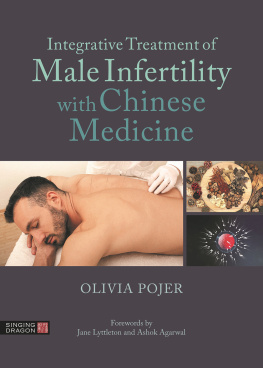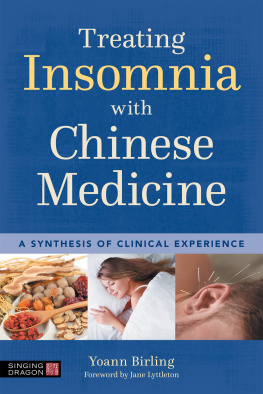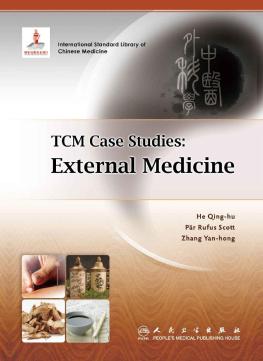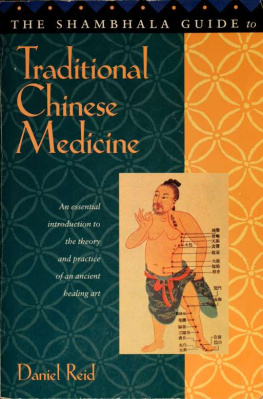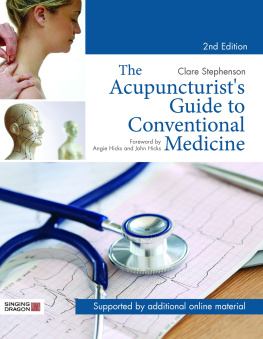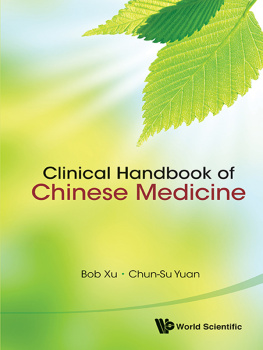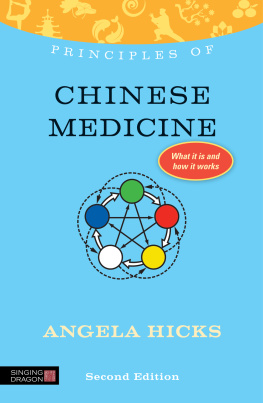Contents
Page list

of related interest
Increasing IVF Success with Acupuncture
An Integrated Approach
Nick Dalton-Brewer
ISBN 978 1 84819 218 8
eISBN 978 0 85701 165 7
Understanding and Treating Hot Flashes in Menopause with Chinese Medicine
Brian Grosam
Foreword by Dr Yubin Lu
ISBN 978 1 78775 538 3
eISBN 978 1 78775 539 0
Acupressure and Acupuncture During Birth
An Integrative Guide for Acupuncturists and Birth Professionals
Claudia Citkovitz
ISBN 978 1 84819 358 1
eISBN 978 0 85701 317 0
Integrative Treatment of
Male Infertility
with Chinese
Medicine
DR OLIVIA POJER
Forewords by Jane Lyttleton and Ashok Agarwal

First published in Great Britain in 2023 by Singing Dragon, an imprint of Jessica Kingsley Publishers
An imprint of Hodder & Stoughton Ltd
An Hachette Company
Copyright Dr Olivia Pojer 2023
Foreword Copyright Jane Lyttleton 2023
Foreword Copyright Dr Ashok Agarwal 2023
Copyright Jessica Kingsley Publishers 2023
Copyright Jessica Kingsley Publishers 2023
The right of Olivia Pojer to be identified as the Author of the Work has been asserted by her in accordance with the Copyright, Designs and Patents Act 1988.
Front cover image source: Shutterstock. The cover image is for illustrative purposes only, and any person featuring is a model.
All rights reserved. No part of this publication may be reproduced, stored in a retrieval system, or transmitted, in any form or by any means without the prior written permission of the publisher, nor be otherwise circulated in any form of binding or cover other than that in which it is published and without a similar condition being imposed on the subsequent purchaser.
The information contained in this book is not intended to replace the services of trained medical professionals or to be a substitute for medical advice. The complementary therapy described in this book may not be suitable for everyone to follow. You are advised to consult a doctor before embarking on any complementary therapy programme and on any matters relating to your health, and in particular on any matters that may require diagnosis or medical attention.
A CIP catalogue record for this title is available from the British Library and the Library of Congress
ISBN 978 1 78775 732 5
eISBN 978 1 78775 733 2
Jessica Kingsley Publishers policy is to use papers that are natural, renewable and recyclable products and made from wood grown in sustainable forests. The logging and manufacturing processes are expected to conform to the environmental regulations of the country of origin.
Jessica Kingsley Publishers
Carmelite House
50 Victoria Embankment
London EC4Y 0DZ
www.singingdragon.com
Dedicated to my daughter Mirjam,
my very personal miracle of life.
Contents
The state of male fertility in most countries in the world is dire and it continues to deteriorate. Sperm numbers are dwindling, their shapes are not normal and some are swimming in circles. And yet there is surprisingly little discussion about this global fertility problem. At the time of writing, there are no quick easy medical cures for male infertility on offer. So here is a book of its time, and its not before time! Infertility affects 15% of couples. That (the WHO tells us) means that 96 to 186 million people are affected worldwide. Male infertility contributes to a half of this number. Thats a heck of a lot of men!
But what are these men doing about it? Sadly, if my patient population (and that of my colleagues) is anything to go by, not very much. From our perspective as clinicians working in fertility, it is not unusual to note that there is often minimal pro-activity in terms of men seeking out treatment for infertility. Added to these shocking global figures is the fact that male infertility is one of the most common reasons for couples attending an IVF clinic. But IVF clinics dont have any cure for under-performing and poor looking sperm (they do however offer a bypass technique known as intracytoplasmic sperm injection or ICSI). In the current era of the ICSI fix for all male infertility issues, IVF clinics have reduced their focus on the male partner to not much beyond a quick semen collection in a jar followed by the steady hand of an expert embryologist. It would not be unreasonable to say that men have been left undervalued, undermanaged and undertreated in this field of infertility.
Enter Chinese Medicine and Olivia Pojer, and the book you hold in your hand which, with its chatty and humorous approach, leaves no stone unturned in its examination of all things male fertility. Let me add that it is not just modern Western Medicine that has neglected men in this field. Historically not much attention was paid to male fertility in Chinese Medicine either (unless of course there were problems with sexual function, and then it got the highest level of attention, a situation not dissimilar to what we might see in modern clinics in the West).
Nan Ke (the study of men) is therefore a relatively new speciality in TCM, and in this book, is compellingly informed by a modern Western understanding of anatomy and physiology. We all have a lot to learn about the intricacies of what goes on in those amazing testicular factories churning out millions upon millions of extraordinary cells shaped like, but much more powerful than, torpedoes. While acknowledging it is still a new science, this book covers everything we currently know about sperm genesis, sperm health, semen analysis and what factors affect these all presented in detail and in easy-to-follow diagrams. And the second half of the book presents what Olivia Pojer calls a bag of tricks, listing many acupuncture and herbal treatment options gathered from Chinese Medicine doctors, both historical and modern.
But lets be honest about this talking (and writing) about treating male infertility is much easier than actually doing it. As alluded to above, its my experience and the experience of most of my colleagues that its not easy to get the blokes to come in for treatment Its not something that just happens in Australia (where I practice TCM); my American and European colleagues have described the same. Those men that do come for treatment for infertility are referred by their female partners (often presenting reluctantly) and many dont stay the distance. In my last few decades of working in infertility I have, more times than I can count, observed the frustration and despair of my female patients who carry most or all of the burden of improving fertility and trying to conceive, while her male partner does little to change habits that might be compromising fertility often because the male reproductive specialist they consulted said No worries mate, your swimmers are great . I see this as a reflection of a blokey culture and am pleased to say it is changing but slowly.
A book like this one is an excellent step in this direction of positive change. Hopefully it will not only inform its readers about TCM and other approaches for male infertility but will also give its readers the confidence to reach out to and educate our young male population (the ones who will be fathering our next generation) to let them know that infertility has nothing to do with virility, that it is common , and that there are some things that can be done other than IVF/ICSI. For us clinicians this book adds important information on what can be gleaned from the semen analysis lab results not the least of which is the window on general and future health that such an analysis can indicate.

